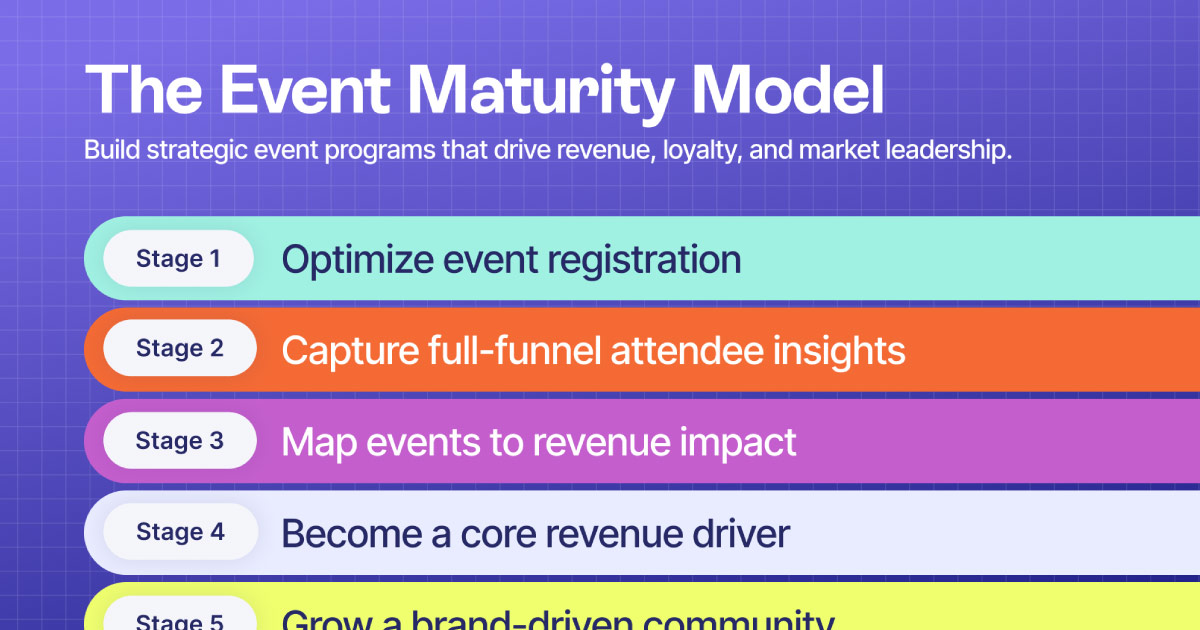As an event leader, true leadership growth requires more than just driving results within your own department. It involves growing your influence so that events are seen as a critical business driver across the company. This requires a laser focus on building strong partnerships with cross-departmental leaders—from sales to marketing to customer experience to other leaders of event programs—to show how collaboration across your event strategy moves the entire business forward.
To break down how you can build those partnerships, we sat down with our very own Katie Golland, director of product marketing at Swoogo (and juggernaut of cross-functional collaboration), for her best tips to form real, strategic partnerships with leaders across the company.
1. Develop genuine connections
Real influence across your business starts with real relationships. People are far more likely to listen, collaborate, and go the extra mile for someone they genuinely like and trust. That trust doesn’t magically appear in meeting rooms or Slack messages—it’s built in the moments between deadlines, in casual conversations, and in the shared understanding that we’re all humans first, professionals second.
“Take the time to ask them how they are, and get to know them as a person. What do they do outside of work?” advises Katie. Not only does this create a genuine connection (that’s just straight-up pleasant), but it also builds that relational equity for when you’ll need to lean on each other.
"Everyone knows—especially in events—things don’t always go as planned. If you don’t have a relationship with someone, it’s hard to make any last-minute ask."Katie Golland, Director of Product Marketing at Swoogo
When your only interactions with other leaders are transactional—requests, approvals, and more requests—you’ll likely feel (and look) heavy-handed, dropping fast ones on their plate. They, in turn, may feel like they’re being taken advantage of. But if you’ve built a genuine connection, they’re far more likely to step in without hesitation.
The Trust Factor
Katie points out two key angles to keep in mind when it comes to those inevitable last-minute asks:
- People help people they like and trust. If you’ve taken the time to build a relationship beyond just work, your colleagues will feel more inclined to help you when you need it. It’s not about manipulation—it’s about mutual respect and goodwill.
- Your track record matters. As Katie puts it, “You've got to build a track record. If you’re known to plan and communicate far in advance, those last-minute asks feel like one-offs rather than a regular occurrence.”
2. Create a prioritization framework
Successful cross-departmental collaboration often comes down to setting the right expectations. Help other leaders understand the level of each ask, and how everything ladders up to the bigger picture, by using a prioritization framework.
For Katie, it helps to have a visible roadmap that outlines key projects and their priority levels.
“On the product side, we tier our launches,” she explains. “An M1 launch is a big deal—we know we’ll need demand gen, customer success, and multiple teams working together. M2 launches still drive demand generation, but are maybe a little less tactical. M3 and M4 are lighter initiatives.”
“Getting clear on your prioritization framework for initiatives—and showing people a roadmap of what's coming—both gets things on their radar and helps them understand how much time and effort is needed.”Katie Golland, Director of Product Marketing at Swoogo
Help everyone understand where to focus their energy, and make sure not everything is a top priority—again, this goes back to transparency and building trust.
How to Put This Into Practice
- Use a prioritization framework and make sure major cross-functional projects are visible to all stakeholders.
- Hold kickoff calls for high-priority initiatives. For major projects (think M1 and M2-level, in our speak), bring all key stakeholders together, share the initiative and what you’re thinking, and collect their thoughts. “Make it feel more collaborative when it moves into the tactical phase,” says Katie. “Once everyone can add their say, then they can solidify their plans in your project management tool.”
- Use project management tools. Platforms like Asana, Monday.com, or Notion can help keep priorities organized and transparent.
- Incorporate updates into existing meetings. Rather than creating more work, integrate project check-ins into meetings that already happen.
- Plan ahead as much as possible. Give teams as much advance notice as possible, so nothing feels like a last-minute scramble.
Having a clear prioritization framework prevents the chaos of competing priorities and ensures all teams stay aligned on what truly matters. This is especially important as events become critical to your larger, cross-functional GTM strategies—a signal of an organization in stage four of the Event Maturity Model.

READ NEXT
3. Ask leaders who they think should be involved
Just like an event experience, you need to know how to get the right people into the room for your cross-functional initiative. Sure, you know which departments need to be involved, but do you know who within that department should be looped in?
Find out tactfully and efficiently by asking the leaders of those teams directly. This helps them feel looped in and heard as well.
Katie points out that there are two ways to approach this:
- The 1:1 roadshow approach: Meet individually with department leaders to brief them on what’s coming, understand their priorities, and determine who on their team should be involved.
- The group kickoff approach: Host a larger kickoff meeting where all relevant leaders are present and can discuss who should be involved from each team.
Knowing your audience matters here. Some teams thrive in collaborative, open discussions where they can riff off each other and debate ideas. Others prefer a more direct, one-on-one approach where they can focus without distractions. Understand your audience and follow suit.
4. Give enough time for two-way feedback
The biggest barrier to successful cross-departmental collaboration with other leaders?
“Time,” shoots Katie (without so much as a blink).
Specifically, when you don’t give other cross-functional leaders enough time to actually react and give input on your initiatives (cough, or collaborate), the partnership breaks down.
Collaboration works best when people feel heard. Forming strong connections with other leaders across your company is often about fostering two-way feedback. That’s why you need to get (majorly) ahead and garner leadership buy-in, ideas, and input from the offset, especially for your big-picture, cross-functional milestones for the year.
“It takes time to collaborate. We plan in terms of annual, quarterly, and monthly alignment. At the annual level, you need true leadership buy-in.”Katie Golland, Director of Product Marketing at Swoogo
5. Prep for meetings that actually get things done
Win influence by being the most prepared person in the room. When you run a meeting, come with your agenda and make sure every participant knows what’s expected, feels equipped to contribute, and sees the value in being there.
“Be prepared with the 'what' and the 'why' so people have enough knowledge to contribute. Otherwise, they’ll check out during your meeting.”Katie Golland, Director of Product Marketing at Swoogo
Katie outlines, “It can look like saying: this is Project X, here's why it matters, here's how I think we can approach it—what do you all think?” Again, preparation is key, but you still want to keep it open enough so others feel empowered to share their ideas.
How to Make Cross-Functional Meetings More Effective
- Set an agenda. Even if you don’t have time to send it in advance, start the meeting by clearly outlining what you’ll cover and why it matters.
- Anticipate what different stakeholders need. If a sales leader is attending, be ready to discuss how the project impacts revenue. If a customer success leader is there, be prepared to touch on retention.
- Make space for collaboration. Instead of just presenting, invite input and create a safe space for sharing ideas.
💡 Pro Tip: Check in with key leaders beforehand. A quick, “Hey, what are the top three things you want covered?”—helps ensure their needs are addressed and that they feel heard before the meeting even starts.
6. Lean into transparency and vulnerability
Influence starts with trust, and trust starts with transparency. Be upfront about your priorities and where they align with others, and importantly, be open about results.
“Don’t just say, ‘we launched that,’ and move on,” says Katie. "Come forward with, ‘Here’s what we did, and here’s what we can work on.’
“Leaning back into vulnerability, call out what you could’ve done to improve. This shows you’re all about getting into the trenches together—and not just what others can do for you.”Katie Golland, Director of Product Marketing at Swoogo
Signal to other leaders that you’re not just here to get things done for yourself and your team. You’re invested in the shared success of the entire company. The more honest and open you are, the easier it becomes to align with other leaders and create a culture of mutual support.
Influence Is Earned, Not Given
At the end of the day, growing your influence and forming strong cross-functional partnerships isn’t about pushing your agenda. It’s about building trust, aligning goals, and creating a culture of collaboration with other leaders. Gain a seat at the leadership table not just by getting buy-in, but by gaining allies.



